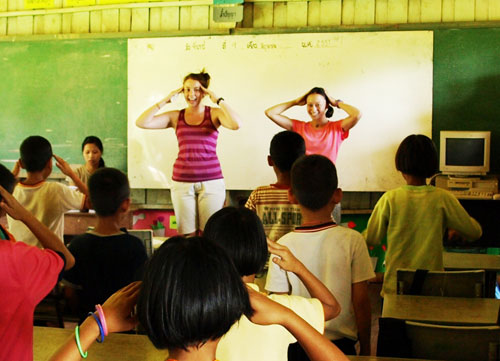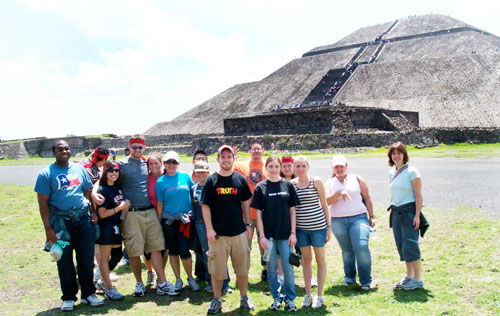Sam Students Have Varied Study Abroad Experiences
 |
| One of the slides from student Claudia Gutarra's PowerPoint presentation on her summer study in Belize. |
The fall of 2008 is not too soon to think about the summer of 2009. And if you ask some of the Sam Houston State University students who scattered throughout the world this past summer to places like Belize, Thailand and Mexico, the early planning is worth the effort.
Biology professor Everett Wilson led the Belize trip. He took 19 students who studied the general field ecology of Belize in Biology 380. His class was full by last September.
“They learn a lot and they talk about it for years,” said Wilson.
The Belize itinerary included the Lamanai Mayan Ruins, a howler monkey sanctuary, the Belize zoo, the Xunantunich ruins, Goff’s Caye island, the Crooked Tree Wildlife Sanctuary, the Belikin Beer brewery, Caye Caulker coral island, jungles, caves, the Caracol ruins, Blue Hole Park, the Marie Sharp pepper sauce factory and a number of towns and villages.
On the other side of the world, Marcus Gillespie, associate professor of geography, was leading a group of 14 students in Thailand. Also going along and serving as an invaluable resource was Gillespie’s wife, Sunisa, who is from Thailand.
In addition to Sunisa helping make travel arrangements for the month-long trip, her family contacts significantly reduced the cost of the trip for the students by allowing them to stay in their homes on six different occasions.
The total cost of the trip for 27 days was $2,578, which included airfare, all meals and transportation in the countries.
Frieda Koeninger, associate professor of foreign languages, coordinated the Puebla Field School, which was begun in the 1940s and has been Sam Houston State’s most popular study abroad effort. That program traditionally has an enrollment of 40-50 students.
Staying with host families is also a valued part of the Mexico program, according to Koeninger.
“They develop close relationships with the families,” she said. “There are always lots of tears when we are saying goodbye.”
A seemingly simple but valuable exercise for the Puebla students is learning to use local public transportation.
 |
| Students Angela Fitchard and Nichole Hahn became teachers in a hill tribe village in Thailand. |
“At first they feel frustrated and exasperated,” said Koeninger, “but once they master their routes, they are so proud of themselves. It is truly an important, though unexpected, life experience. They find out that they can meet and surmount challenges successfully.”
This year Koeninger took her intermediate Spanish students downtown and showed them her favorite street food. They went to a market and bought fruits and vegetables. They also made out a questionnaire and interviewed people on the street.
All of the Puebla students went to archeological sites such as Teotihuacan, Cholula and Cacaxtla, to the National Museum of Anthropology and to factories that make the Puebla tile called “talavera.”
Business students visited the Volkswagen factory, a company that makes parts for the VW plant, the soft drink company Big Cola, as well as places of cultural importance such as the site of the battle of Cinco de Mayo.
Gillespie’s group visited the temple complex of Angkor Wat in Cambodia and such well-known Thai sites as the Temple of the emerald Buddha, Grand Place and Wat Po in Bangkok.
They also saw the Sukhothai historic ruins, the king’s summer palace, a hill tribe village, a coastal research center, orchards, orchid farms, and a rainforest. They stayed overnight at an oyster farm located three miles offshore and in Thai houses that are about 100 years old.
They swam at the base of a waterfall, rode elephants, went snorkeling, sea kayaking, river kayaking, white water rafting, hiking and caving. They also rode an overnight train on two occasions.
“It was a genuine adventure,” said Gillespie, “especially for those who had never done anything like this. One had never been on a plane and several had never been out of the country.”
Study abroad is just that—unique in its educational value—said Gillespie.
“They experience things they could never experience in a classroom,” he said. “By meeting people from other cultures, seeing the way of life of different people, learning about other people from other cultures, learning about other religions, and even eating different foods, it enhances a student’s understanding of both the other culture and their own as well.”
 |
| Ruins such as Mexico's Pyramid of the Sun in Teotihuacan were popular stops for study abroad students. |
Gillespie also likes to emphasize that when U. S. students travel abroad, whether they know it or not, they are scrutinized by those they visit, and should make their best efforts to be good ambassadors.
One of the highlights of this year’s trip was when students Nichole Hahn and Angela Fitchard went into a classroom in a hill tribe village.
“The guide and teacher eagerly agreed,” said Gillespie, “and in a matter of minutes Niki and Angela were leading the students in the song ‘Head, Shoulders, Knees and Toes.’ It was a wonderful cross-cultural experience.”
Keelie Hughes went to Puebla to study Spanish, and came home with wonderful memories as well.
“I loved every minute of it,” said Hughes. “I had never been on a plane, nor been out of the country before, so I dove in headfirst. I opted to stay in the hotel rather than with a family because I didn't think I would be comfortable living with someone whose language I did not know. I now realize that living with the family would have forced me to learn even more of their language.”
Hughes likes to remember the last weekend of her trip, to the small rainforest city of Cuetzalan. Not only did she and friends visit caverns and a waterfall, but rappelled off the waterfall.
She also learned that professors sometimes have good reasons for making dumb assignments, like having students keep a diary.
"At the time this was very annoying," said Hughes, "but now it is great to reflect on what I had written and also be able to put pictures to the different events. I'm glad for that assignment."
Overall, Hughes gives the study abroad program a big thumbs up.
“The trip was a wonderful experience,” Hughes said, "and I highly recommend it to anyone who is able to go.”
- END -
SHSU Media Contacts: Frank Krystyniak
Aug. 21, 2008
Please send comments, corrections, news tips to Today@Sam.edu
This page maintained by SHSU's Communications Office
Director: Bruce Erickson
Assistant Director: Julia May
Writer: Jennifer Gauntt
Located in the 115 Administration Building
Telephone: 936.294.1836; Fax: 936.294.1834
Please send comments, corrections, news tips to Today@Sam.edu.
- Undergrads Present Research
- Del Carmen Wins National Award
- Prof Chews On Geophagy Research
- April Recognized As Awareness Month
- CJ Honors Its Outstanding
- Center Hosts Awareness Activities
- President's Retirement Event Held
- Hooten Named Men's Basketball Coach
- Ring Ceremony Breaks Record
- Trip Takes Summer Classes West
- SHSU Receives First Patent Royalties
- 'Bone Lady' Gives 'Faculty' Lecture
- Seminar Gives Health Care Facts
- Research Clinic Benefits Children
- University Opens Regional Crime Lab
- Distinguished Educators Named
- Grad First Woman To Get Bar Award
- Week Prepares Students For Break
- Documentarian Gives Lectures
- Regents Approve Center Renovation
- Faculty, Staff Giving Breaks Records
- Events Celebrate Namesake, Texas
- Center Holds Financial Literacy Week
- SHSU Sends System To Afghanistan
- New Technology Aids In Fighting Crime
- Students Sought For Rural Internships
- SHSU Receives Incentive Check
- Musicians To Participate In Exchange
- Doctoral Program Earns Accreditation
- Class Recycles Sustainability Idea
- Week Prepares Students For V-Day
- SHSU Web Site Gets Redesign
- Fritz Named Head Football Coach
- Funds Donated For Center Renovation
- Center Establishes Mentorship Award
- Blatchley, Bamberg Are Grad Speakers
- H1N1 Vaccine Available For Students
- Regents Approve Tuition, Fee Increases
- Fifth Graders Get Science Lessons
- STAFS Provides Solutions In First Year
- Students Make Peanut Butter For Project
- Mentoring Program Helps CS Students
- Dean Offers Eating Tips For Students
- Four Named To COBA Hall Of Honor
- Water Treatment Technology Produced
- Rivalry Game Moving To Houston
SHSU 'In the News'
Brian Domitrovic, assistant professor of history, appeared on Book TV (C-SPAN) May 1-2, speaking about his recent book "Econoclasts: The Rebels Sparked the Supply Side Revolution and Restored American Prosperity" (www.econoclasts.net).
Houston Chronicle education writer Jeannie Kever recently turned to Regents Professor of English Paul Ruffin for his views on university presses moving toward "digital books" as opposed to traditional ink-on-paper."We're fulfilling the ancient role of the university press, and that is to produce books," said Paul Ruffin, the Texas poet laureate for 2009 and director of the Texas Review Press at Sam Houston State University. "I don't want to give up the book because it is an art."
Faculty/Staff Birthdays
Monday, May 3
Tuesday, May 4
Staff Council Spotlights
